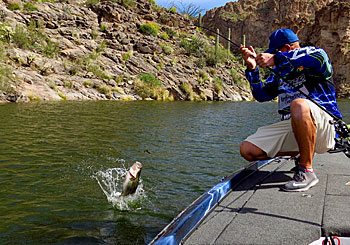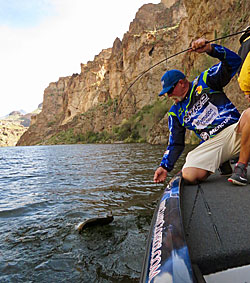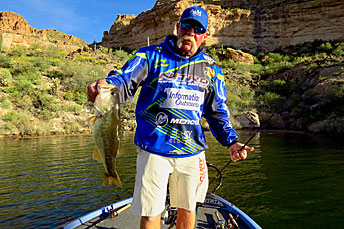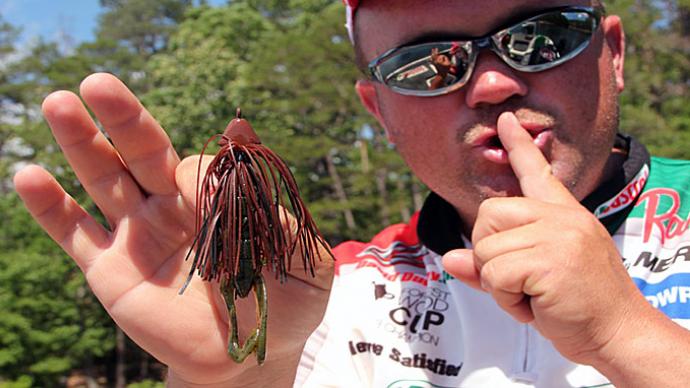
Spring comes early in the low desert, so we are already in post-spawn conditions, and before we know it, it’ll be summer. In your neck of the woods, you may still be in pre-spawn, or the fish could be on beds right now. One thing to remember is that not all fish spawn simultaneously. Marty Lawrence says there could be as many as three to four waves of spawning fish every time the moon gets right. That means that even if fish are on the beds, you can still catch a bunch in the pre and post-spawn areas. You need to know where those are.
Once you find bass in these conditions, your chances are good of finding at least a couple more in the immediate vicinity. This will usually happen by breaks, ridges, or river channels. Lawrence, one of our best Arizona bass pros, likes to target these fish with a Texas-rigged craw or creature bait. For one thing, you can work a Texas rig across the bottom very slowly if you need to, but you can also swim it as fast as you can reel, and it will still catch fish. He usually starts slowly, getting it on the bottom in 5-25 feet, then dragging it over the rocks.
“If you hit a rock, pop it,” he says, “they often hit it then.” Later in the day, they may get so active they grab it the instant it hits the water. Post spawn fish, in particular, are trying to feed up – the spawn takes a lot out of them, and craws are the ideal food to get fattened up on. Even if Marty doesn’t catch a fish right away, he’ll throw the craw all day long – they’re going to come up sometime, and they’ll eat that craw. “Everything is fixated on the bottom right now,” he says. “Anything that crawls through where they’re fixin’ to make a bed or thinking about making a bed, they’ll eat it.” That goes for after the bed-making period as well.

He targets points and drop-offs close to the spawning coves and drags the craw all over it from various angles. Because craws love to live in rocks, he favors a tungsten weight because you can feel the rocks well with it, and it has a smaller profile, so it can sometimes slip through places that a lead weight can’t. He rigs the craws on a 3/0 wide gap hook and 12-pound fluorocarbon line. This setup gives him an excellent feel for what’s happening with the craw.
Even though he fishes the craw slowly, he covers water pretty quickly because once he’s out of that 25-foot depth, he reels it in and re-casts. He goes from cut to cut, drop-off to drop-off, fishing the high probability spots and not spending too much time on each spot unless he gets bit. When you fish the channel in a cove, check the landscape along the sides of the cove. If there are little cuts on shore, you can be sure they continue out and join up with the main channel. These little secondary channels can be an absolute gold mine. And don’t forget to check that little underwater point that forms where the two channels meet.
The craw is perfect for fishing through things like submerged trees and brush. A good tree can hold a whole school of fish, and since Texas has a point protected, you can get it through the branches. John Murray, the BASS pro who spent most of his life fishing in Arizona, says that you can be facing a bank covered with miles of brush, but the fish will be concentrated for whatever reason. You need to pay attention to where you are finding them.
Murray says he lets the cover decide the lure. He’ll throw a big tandem willow spinnerbait in brush with an extended ribbon trailer. The bite will feel like someone cut the line. If the vibration changes, he says – set the hook! If he feels like the spinnerbait has been overfished, he’ll go to a jig or craw or a Gitzit on 1/16- or 1/8-ounce weight, dragging it slowly, maybe lifting it just a tiny bit now and then.
Fish tighten up this time of year, so finesse is a great way to catch them, but you can also catch them on reaction baits. A crankbait will not only cover a lot of water, it will eliminate dead water for you, and you can also pick up better fish sometimes. The earlier it is in the season, the more the fish will be moving up and down, and a reaction bait can find you some active fish. You may even want to stop and throw a craw at them once you get one on a crankbait.

Another reaction bait to try this time of year is a topwater bait. First, because after the bass spawn, there are balls of newly hatched bass in the water, and the males stay around to protect them. They will attack anything that threatens the babies, so a noisy topwater like a Rico is excellent. Look for those clouds of tiny fish and throw them right over them. A second reason to try a topwater is that the females will go out and suspend, and a topwater can get them to come up and eat. If followers are plaguing you, throw the same bait over that spot, or use a War Eagle Front Runner.
Some topwater tips: even though many people say to set the hook when you feel the fish, it pays to ignore that and set the hook as soon as the bait is gone. If you don’t see it on top, a fish has it. They often grab it and swim right at you; you’ll never feel it. It’s easy to lose fish on a topwater, so change the hooks to EWG Gamakatsu treble hooks, even upsizing a little if you can. On a Rico, try using one a size bigger on the front. Also, put a split ring on the front – the eye can be sharp and cut your line. A heavier line helps as well. Use 15- to 20-pound mono: it casts well and doesn’t sink. When the lure stops, you want it to stay on the surface. You can get away with braid with a Spook, buzzbait, or something that moves all the time.
Grassy lakes tend to be more consistent this time of year because of the food base. Rocky lakes can be a little more challenging. When the post-spawn shallows start to heat up and stagnate, the fish will move out into deeper, colder water that holds more oxygen. They’ll pull out even deeper as the weeds start to die. The whole food chain moves out, and if the lake has craws, they’ll key in on them at this time.
Those crawdad fish are more consistent, and if you can find a nice rocky bank or a rockpile with a population of craws, it can be a go-to spot for weeks. When the water drops, the breaks off flats can be dynamite – all the fish and bait on that flat have to move out, and you can be there waiting for them.
Bottom line this time of year: search locations between spawning flats and deep water, especially breaks, ridges, points, and drop-offs. Don’t neglect cover on these types of structure, and let the cover and structure dictate the lure choice. When you get bit, stick around and see if they are schooled up there. Find a milk run of great places, and you’ll be set for great days on the water clear into summer.




